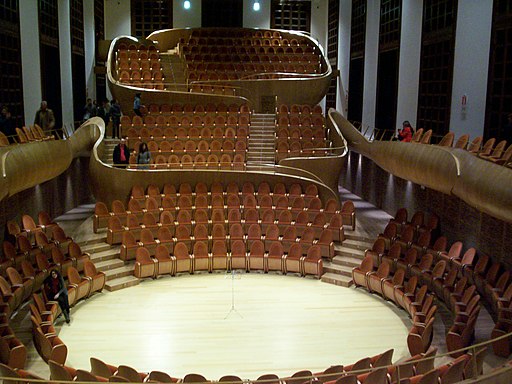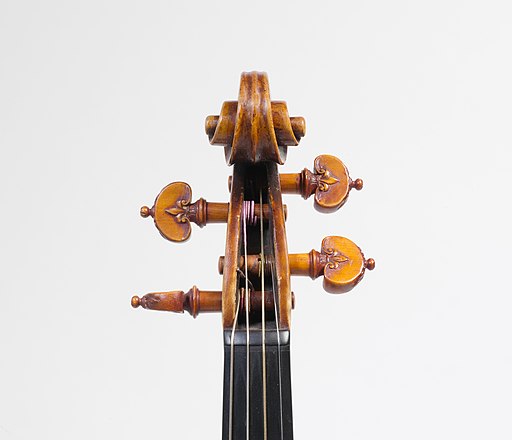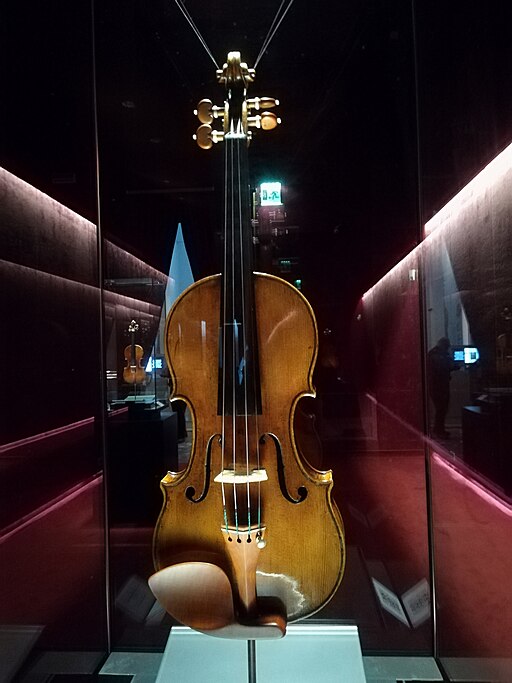Traditional violin craftsmanship in Cremona
Cremona is a beautiful city located between the regions of Lombardy and Emilia Romagna. Famous for the ancient tradition of violin making. This, in fact, is the most characteristic element of the city. So much so that it can be said that the history of Cremona cannot be separated from its lutherie workshops. We could indeed say that Cremona and violins are almost synonymous. In fact, the best violins in the world have been made here for 500 years. The collection of musical instruments kept in the Violin Museum testifies that this craftsmanship in Cremona is an extraordinary cultural heritage of the city. It allows you to discover up close the violins made by the great master luthiers. Such as Amati, Stradivari and Guarneri.
 Andrea Amati, CC0, via Wikimedia Commons
Andrea Amati, CC0, via Wikimedia Commons
Still today, in Cremona, aspiring luthiers attend a highly specialized school, based on a close relationship among teachers and students. And learn in the laboratory the techniques of making violins according to the ancient traditions of Cremonese violin making. Allowing to specialize and become custodian of a method of making violins that has made school. Because it is capable of distinguishing itself on the world scene. This is why hundreds of students from all over the world choose to study in Cremona every year. The school therefore caters to national and international users. Both students leaving lower secondary school and adults, with qualifications of all levels and the most varied work experiences.
The luthier cultural heritage of Cremona
Cremona is therefore the world capital of violin making, the ancient art of making the violin and other stringed instruments. A record the city is proud of. Because, among all musical instruments, the violin is the one that best touches the strings of feelings and arouses emotions. UNESCO, in 2012, included the ancient tradition of Cremonese violin making in the list of the Intangible Cultural Heritage. With the aim of safeguarding the craftsmanship skills and knowledge of violin makers. And keeping alive the ancient tradition of Cremonese violin making. So that the transmission of techniques and methods endure and be handed down over time.
Violin Museum
Following the important recognition by UNESCO. The Violin Museum opened in 2013 at the Art Palace of Cremona. Which collects the 12 most significant instruments of the great Cremonese violin-making school. From the first half of the 16th century to the first half of the eighteenth century. The oldest one is the Carlo IX by Andrea Amati from 1566; the most recent is the violin by Simone Fernando Sacconi from 1941. Thanks to the contribution of the Municipality of Cremona and the “Walter Stauffer” Musicology Center. The museum exhibits the highest and complete testimony of bowed instruments of the Cremonese school.
A new auditorium was also created inside the museum to listen to music played with instruments made in Cremona. The Auditorium, designed by sound engineer Yasuhisa Toyota, is a 460-seat wooden hall. With the stage in the center and the audience around it. Where each object has been designed to achieve extraordinary sound quality.
 Photo by BerneriFrancesca, CC BY-SA 4.0, via Wikimedia Commons
Photo by BerneriFrancesca, CC BY-SA 4.0, via Wikimedia Commons
The tools from Antonio Stradivari’s workshop. In addition to forms, documents and relics, can instead be admired at the Stradivari Museum. Wich collects a collection of over 60 stringed instruments. Built by Italian luthiers from the second half of the nineteenth century to the first half of the twentieth century. The museum also hosts an educational itinerary. That illustrates the phases of construction of the violin according to the tradition of the classical Cremonese school.
A little history of violin making
The Cremonese violin making has its roots in the artisan knowledge of Andrea Amati. Who began his activity in Cremona around 1520. According to many scholars, he was the first to build the violin. The Amati family produced instruments of the highest quality. And for this reason they were able to satisfy the requests of Italian and foreign courts. Catherine de ‘Medici herself, mother of the very young King of France Charles IX, commissioned some instruments from Andrea.
Andrea Amati defined what a violin is and established the canons still valid today. Andrea had two sons, Antonio and Girolamo, who succeeded him in the workshop. At the workshop of Andrea Amati’s descendants. The Guarneri and Stradivari families learned the art and perfected it in the seventeenth and eighteenth centuries. Starting an evolutionary process unique in the world over three centuries. In these three hundred years there have been families of luthiers who have passed on the production tradition from father to son for several generations.
The famous violin craftsmanship in Cremona
Their fame traveled throughout Europe. The royal and princely courts commissioned musical instruments from Cremonese luthiers. And the most famous musicians aspired to own them. Owning a violin that came out of their workshops was in fact, for the main European courts and the greatest musicians, not only a sign of distinction. But a guarantee of an excellent quality of the instrument. Soon the name of Cremona, as the city of violins, became famous throughout the world.
The quality of the Cremonese violin making products, however, experienced a slow decline from the end of the 18th century and throughout the 19th century. Even if important luthiers worked in the cities in that century. But in the twentieth century the foundations were laid for its relaunch. Especially with the launch of the International School of Lutherie. And a prestigious collection of historical masterpieces which today counts 11 musical instruments. Today Cremona, with its over 130 shops, has once again become the reference point for international lutherie.
The construction techniques
Bowed instruments can be made with different methods. But the Cremonese luthiers have developed a technique considered unique in the world. For each instrument, more than 70 different pieces of wood are modeled and assembled by hand. Such as fir, maple, ebony, willow, poplar, rosewood, mahogany, cedar or other traditional essences. Furthermore, each part of the violin must be made with a particular wood and naturally seasoned. No semi-industrial or industrial materials are used. The talent of these wood artists lies in giving body to the sound.
 Andrea Amati, CC0, via Wikimedia Commons
Andrea Amati, CC0, via Wikimedia Commons
The construction of the traditional violin therefore requires a deep knowledge of natural materials and techniques handed down from generation to generation. The varnish is then applied using special brushes which, with its transparency, will maximize the grain of the wood. It is in the choice of materials. And in the design of the shape and curves that the perfect sound finds its maximum expression.
The Complex violin craftsmanship in Cremona
Due to the complexity and accuracy of the realization. Each luthier builds a maximum of 3 to 6 musical instruments per year. As the construction of a violin requires about two hundred and twenty hours of work. No violin is the same as another. And each violin expresses the originality and personality of the master luthier. Respecting the processing techniques typical of the Cremonese luthier tradition and its evolutions. It is not just a matter of applying technical knowledge and deep experience to the creation of an instrument. But of instilling in it the very soul of those who build it.
 Photo by Waltramp, CC BY-SA 4.0, via Wikimedia Commons
Photo by Waltramp, CC BY-SA 4.0, via Wikimedia Commons
The shape of the Cremonese violin is the most suitable to improve the acoustic and stylistic possibilities of the instrument. And at the same time to give the luthier freedom of interpretation. Even today, respecting tradition, violins production process in Cremona cannot use industrial equipment or technologies:
a) painted without using spray paint;
b) produced without using industrial semi-finished products;
c) produced with fir, maple, ebony, willow, poplar, rosewood, mahogany, cedar or other essences traditionally used in the construction of instruments.
The violin Craftsmanship in Cremona today
In Cremona, two associations promote the traditional violin:
– the “Consortium of violin makers Antonio Stradivari” (which includes about 60 master violin makers from Cremona and its province) and
– the “Associazione Liutaria Italiana“
which, together, play a fundamental role in promoting social activities and cultural events. As well as in the organization of events in the city of violins. Their aim is to promote and enhance Cremonese contemporary lutherie. Which operates in compliance with the artisan tradition of the great masters of the past. Whose art is known and admired all over the world. And is an inexhaustible source of inspiration for modern lutherie.
 Photo by Hildegard Dodel, Public domain, via Wikimedia Commons
Photo by Hildegard Dodel, Public domain, via Wikimedia Commons
Today in Cremona it is also possible to visit the workshops during which the master luthiers illustrate the main stages of processing for the craftsmanship of string instruments. The luthier, in his workshop, tells the tradition, shows the tools and techniques for making the violin. The luthier’s workshop is a place where it is possible to see at work the skilled gestures of the artisans who, today as in the past, know how to draw a sweet and melodious sound from wood and paints.
Musical Training
Cremona is today both the capital of violin making, but it is also an important center of musical training. Music is an experience that permeates city life at all levels. Furthermore, since 2016 in Cremona, at the Department of Musicology and Cultural Heritage is active the only degree course in Italy enabling the profession of restorer of musical instruments and scientific instruments. This is a course that allows you to intervene on protected musical instruments from public and private collections. Furthermore, at the Museo del Violino there is also the laboratory that applies the most advanced techniques and methods of investigation for the study of historical musical instruments.
Everything in Cremona is about violin and music.
Resume
Traditional Cremonese violin making is an ancient form of craftsmanship typical of Cremona. Where bowed instruments such as violins, violas, cellos and double basses have been made for centuries. The high quality of Cremonese violin making has developed for three hundred years with the great families. Such as Amati, Bergonzi, Guarneri, and especially with Antonio Stradivari. Today Cremona, with its over 130 luthier shops, is the reference point for international lutherie, born here 500 years ago.
The Cremonese violin making is in fact an example of “excellence” of artistic craftsmanship. It is in this city that violins that will play the greatest musicians in the world are born. Who will enter the most famous and prestigious theaters of all Countries, at every latitude. Instruments capable of telling the music. Instruments that have made the history of music. Since 2012, this ancient tradition has become part of the UNESCO Intangible Cultural Heritage list.
